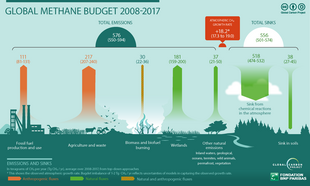
Arctic methane emissions contribute to a rise in methane concentrations in the atmosphere. Whilst the Arctic region is one of many natural sources of the greenhouse gas methane, there is nowadays also a human component to this due to the effects of climate change.[2] In the Arctic, the main human-influenced sources of methane are thawing permafrost, Arctic sea ice melting, clathrate breakdown and Greenland ice sheet melting. This methane release results in a positive climate change feedback (meaning one that amplifies warming), as methane is a powerful greenhouse gas.[3] When permafrost thaws due to global warming, large amounts of organic material can become available for methanogenesis and may therefore be released as methane.[4]
Since around 2018, there has been consistent increases in global levels of methane in the atmosphere, with the 2020 increase of 15.06 parts per billion breaking the previous record increase of 14.05 ppb set in 1991, and 2021 setting an even larger increase of 18.34 ppb.[5] However, there is currently no evidence connecting the Arctic to this recent acceleration.[6] In fact, a 2021 study indicated that the methane contributions from the Arctic were generally overestimated, while the contributions of tropical regions were underestimated.[7]
Nevertheless, the Arctic's role in global methane trends is considered very likely to increase in the future. There is evidence for increasing methane emissions since 2004 from a Siberian permafrost site into the atmosphere linked to warming.[8]
Mitigation of CO2 emissions by 2050 (i.e. reaching net zero emissions) is probably not enough to stop the future disappearance of summer Arctic Ocean ice cover. Mitigation of methane emissions is also necessary and this has to be carried out over an even shorter period of time.[9] Such mitigation activities need to be carried out in three main sectors: oil and gas, waste and agriculture. Using available measures this could amount to global reductions of ca.180 Mt/yr or about 45% of the current (2021) emissions by 2030.[10]
- ^ Saunois, M.; Stavert, A.R.; Poulter, B.; et al. (July 15, 2020). "The Global Methane Budget 2000–2017". Earth System Science Data (ESSD). 12 (3): 1561–1623. Bibcode:2020ESSD...12.1561S. doi:10.5194/essd-12-1561-2020. ISSN 1866-3508. Retrieved 28 August 2020.
- ^ Bloom, A. A.; Palmer, P. I.; Fraser, A.; Reay, D. S.; Frankenberg, C. (2010). "Large-Scale Controls of Methanogenesis Inferred from Methane and Gravity Spaceborne Data" (PDF). Science. 327 (5963): 322–325. Bibcode:2010Sci...327..322B. doi:10.1126/science.1175176. PMID 20075250. S2CID 28268515.
- ^ Cheng, Chin-Hsien; Redfern, Simon A. T. (23 June 2022). "Impact of interannual and multidecadal trends on methane-climate feedbacks and sensitivity". Nature Communications. 13 (1): 3592. Bibcode:2022NatCo..13.3592C. doi:10.1038/s41467-022-31345-w. PMC 9226131. PMID 35739128.
- ^ Zimov, Sa; Schuur, Ea; Chapin, Fs 3Rd (Jun 2006). "Climate change. Permafrost and the global carbon budget". Science. 312 (5780): 1612–3. doi:10.1126/science.1128908. ISSN 0036-8075. PMID 16778046. S2CID 129667039.
{{cite journal}}: CS1 maint: numeric names: authors list (link) - ^ Cite error: The named reference
:2was invoked but never defined (see the help page). - ^ Cite error: The named reference
:3was invoked but never defined (see the help page). - ^ Cite error: The named reference
:4was invoked but never defined (see the help page). - ^ Cite error: The named reference
:5was invoked but never defined (see the help page). - ^ Cite error: The named reference
:1was invoked but never defined (see the help page). - ^ Cite error: The named reference
:0was invoked but never defined (see the help page).